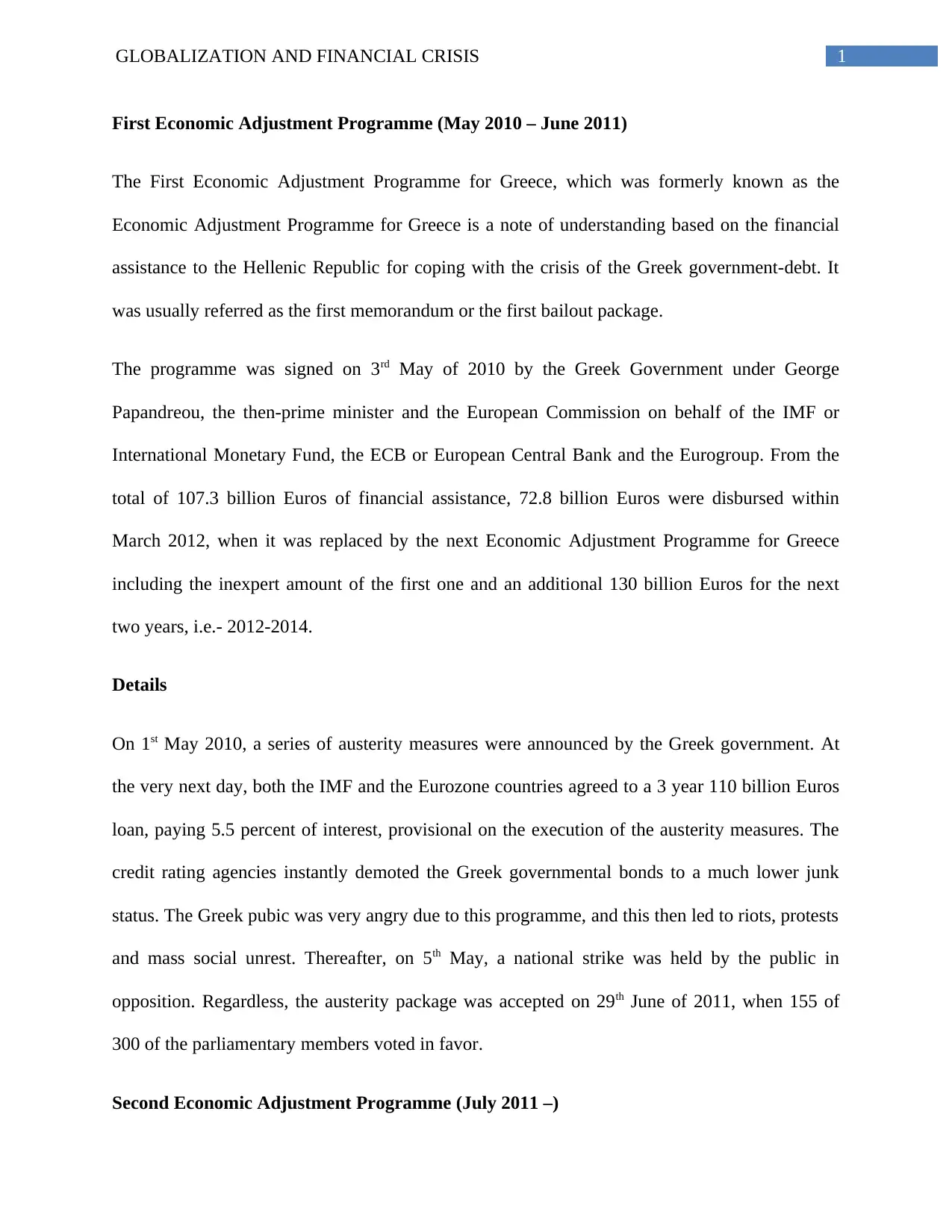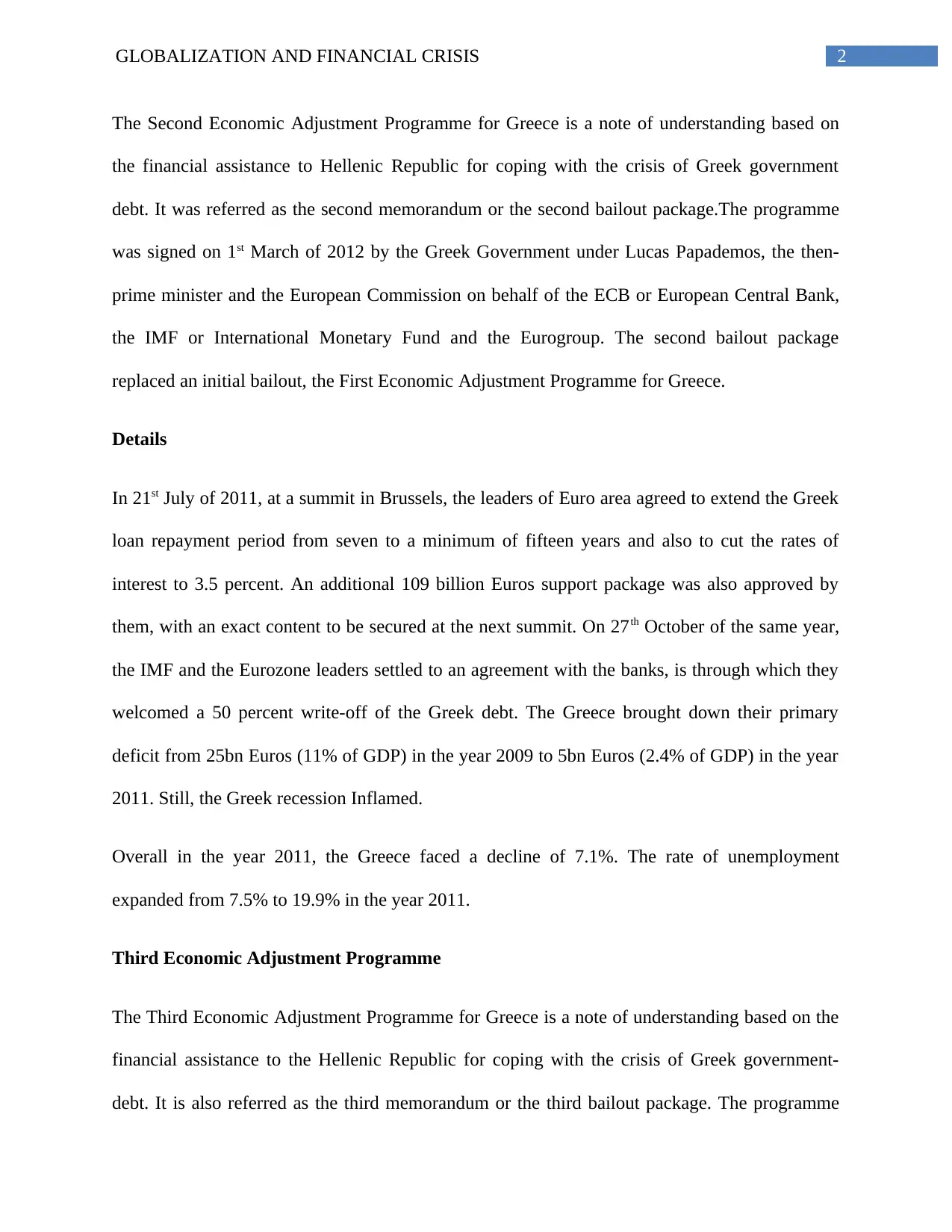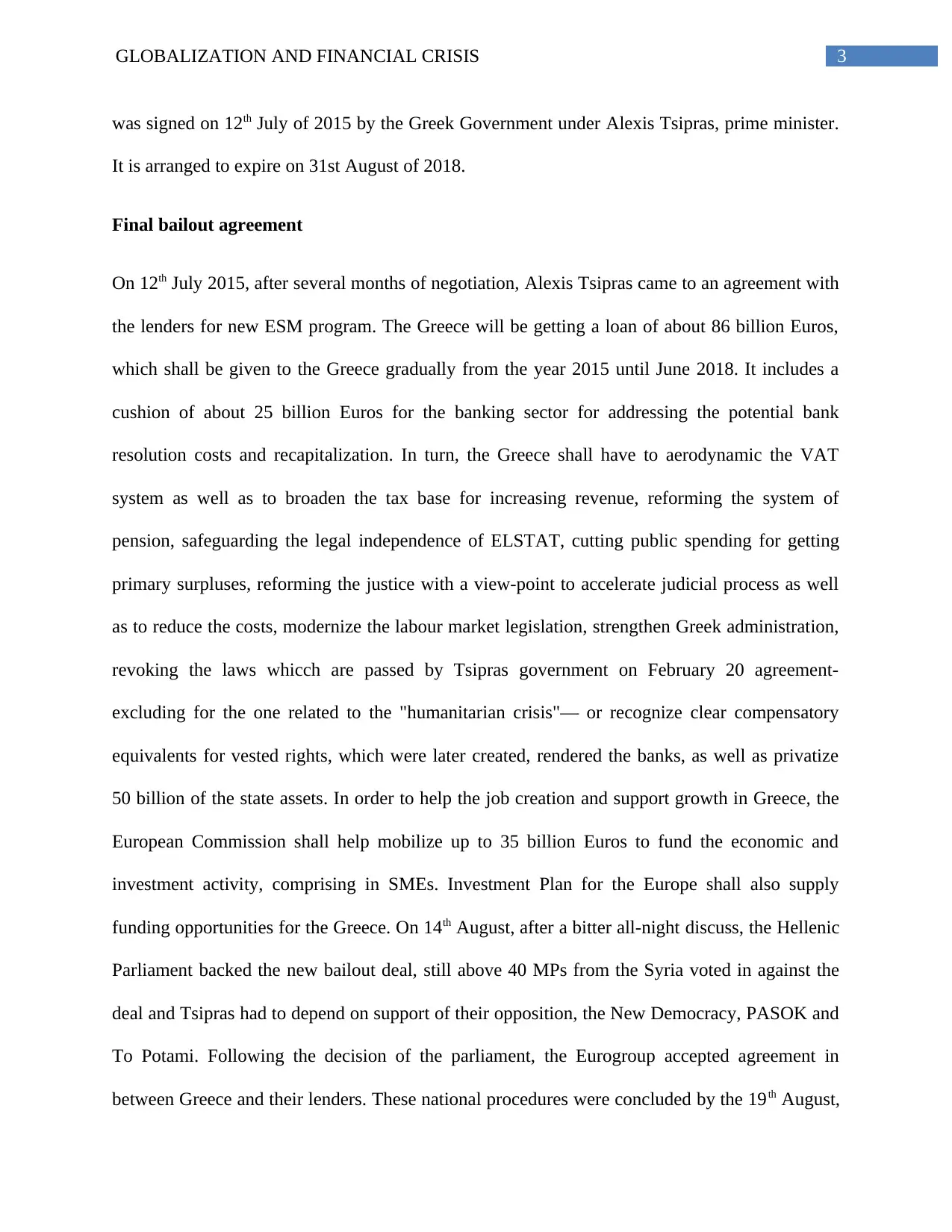Examining Greece's Economic Adjustment Programmes Post-Crisis
VerifiedAdded on 2023/06/15
|5
|1106
|283
Report
AI Summary
This report provides an overview of the three Economic Adjustment Programmes implemented in Greece to address the government-debt crisis, examining the initial program in May 2010, the second in July 2011, and the third in July 2015. Each program involved financial assistance from the IMF, ECB, and Eurogroup, contingent on austerity measures and economic reforms. The report details the terms of each bailout package, including loan amounts, interest rates, and required policy changes, as well as the social and political consequences, such as public protests and government instability. It also highlights the ongoing efforts to stabilize the Greek economy and the role of international institutions in the process. The final bailout agreement and its conditions, including VAT reforms, pension system adjustments, and privatization of state assets, are also discussed.

Running head: GLOBALIZATION AND FINANCIAL CRISIS
Globalization and Financial Crisis
Name of the Student:
Name of the University:
Author note:
Globalization and Financial Crisis
Name of the Student:
Name of the University:
Author note:
Paraphrase This Document
Need a fresh take? Get an instant paraphrase of this document with our AI Paraphraser

1GLOBALIZATION AND FINANCIAL CRISIS
First Economic Adjustment Programme (May 2010 – June 2011)
The First Economic Adjustment Programme for Greece, which was formerly known as the
Economic Adjustment Programme for Greece is a note of understanding based on the financial
assistance to the Hellenic Republic for coping with the crisis of the Greek government-debt. It
was usually referred as the first memorandum or the first bailout package.
The programme was signed on 3rd May of 2010 by the Greek Government under George
Papandreou, the then-prime minister and the European Commission on behalf of the IMF or
International Monetary Fund, the ECB or European Central Bank and the Eurogroup. From the
total of 107.3 billion Euros of financial assistance, 72.8 billion Euros were disbursed within
March 2012, when it was replaced by the next Economic Adjustment Programme for Greece
including the inexpert amount of the first one and an additional 130 billion Euros for the next
two years, i.e.- 2012-2014.
Details
On 1st May 2010, a series of austerity measures were announced by the Greek government. At
the very next day, both the IMF and the Eurozone countries agreed to a 3 year 110 billion Euros
loan, paying 5.5 percent of interest, provisional on the execution of the austerity measures. The
credit rating agencies instantly demoted the Greek governmental bonds to a much lower junk
status. The Greek pubic was very angry due to this programme, and this then led to riots, protests
and mass social unrest. Thereafter, on 5th May, a national strike was held by the public in
opposition. Regardless, the austerity package was accepted on 29th June of 2011, when 155 of
300 of the parliamentary members voted in favor.
Second Economic Adjustment Programme (July 2011 –)
First Economic Adjustment Programme (May 2010 – June 2011)
The First Economic Adjustment Programme for Greece, which was formerly known as the
Economic Adjustment Programme for Greece is a note of understanding based on the financial
assistance to the Hellenic Republic for coping with the crisis of the Greek government-debt. It
was usually referred as the first memorandum or the first bailout package.
The programme was signed on 3rd May of 2010 by the Greek Government under George
Papandreou, the then-prime minister and the European Commission on behalf of the IMF or
International Monetary Fund, the ECB or European Central Bank and the Eurogroup. From the
total of 107.3 billion Euros of financial assistance, 72.8 billion Euros were disbursed within
March 2012, when it was replaced by the next Economic Adjustment Programme for Greece
including the inexpert amount of the first one and an additional 130 billion Euros for the next
two years, i.e.- 2012-2014.
Details
On 1st May 2010, a series of austerity measures were announced by the Greek government. At
the very next day, both the IMF and the Eurozone countries agreed to a 3 year 110 billion Euros
loan, paying 5.5 percent of interest, provisional on the execution of the austerity measures. The
credit rating agencies instantly demoted the Greek governmental bonds to a much lower junk
status. The Greek pubic was very angry due to this programme, and this then led to riots, protests
and mass social unrest. Thereafter, on 5th May, a national strike was held by the public in
opposition. Regardless, the austerity package was accepted on 29th June of 2011, when 155 of
300 of the parliamentary members voted in favor.
Second Economic Adjustment Programme (July 2011 –)

2GLOBALIZATION AND FINANCIAL CRISIS
The Second Economic Adjustment Programme for Greece is a note of understanding based on
the financial assistance to Hellenic Republic for coping with the crisis of Greek government
debt. It was referred as the second memorandum or the second bailout package.The programme
was signed on 1st March of 2012 by the Greek Government under Lucas Papademos, the then-
prime minister and the European Commission on behalf of the ECB or European Central Bank,
the IMF or International Monetary Fund and the Eurogroup. The second bailout package
replaced an initial bailout, the First Economic Adjustment Programme for Greece.
Details
In 21st July of 2011, at a summit in Brussels, the leaders of Euro area agreed to extend the Greek
loan repayment period from seven to a minimum of fifteen years and also to cut the rates of
interest to 3.5 percent. An additional 109 billion Euros support package was also approved by
them, with an exact content to be secured at the next summit. On 27th October of the same year,
the IMF and the Eurozone leaders settled to an agreement with the banks, is through which they
welcomed a 50 percent write-off of the Greek debt. The Greece brought down their primary
deficit from 25bn Euros (11% of GDP) in the year 2009 to 5bn Euros (2.4% of GDP) in the year
2011. Still, the Greek recession Inflamed.
Overall in the year 2011, the Greece faced a decline of 7.1%. The rate of unemployment
expanded from 7.5% to 19.9% in the year 2011.
Third Economic Adjustment Programme
The Third Economic Adjustment Programme for Greece is a note of understanding based on the
financial assistance to the Hellenic Republic for coping with the crisis of Greek government-
debt. It is also referred as the third memorandum or the third bailout package. The programme
The Second Economic Adjustment Programme for Greece is a note of understanding based on
the financial assistance to Hellenic Republic for coping with the crisis of Greek government
debt. It was referred as the second memorandum or the second bailout package.The programme
was signed on 1st March of 2012 by the Greek Government under Lucas Papademos, the then-
prime minister and the European Commission on behalf of the ECB or European Central Bank,
the IMF or International Monetary Fund and the Eurogroup. The second bailout package
replaced an initial bailout, the First Economic Adjustment Programme for Greece.
Details
In 21st July of 2011, at a summit in Brussels, the leaders of Euro area agreed to extend the Greek
loan repayment period from seven to a minimum of fifteen years and also to cut the rates of
interest to 3.5 percent. An additional 109 billion Euros support package was also approved by
them, with an exact content to be secured at the next summit. On 27th October of the same year,
the IMF and the Eurozone leaders settled to an agreement with the banks, is through which they
welcomed a 50 percent write-off of the Greek debt. The Greece brought down their primary
deficit from 25bn Euros (11% of GDP) in the year 2009 to 5bn Euros (2.4% of GDP) in the year
2011. Still, the Greek recession Inflamed.
Overall in the year 2011, the Greece faced a decline of 7.1%. The rate of unemployment
expanded from 7.5% to 19.9% in the year 2011.
Third Economic Adjustment Programme
The Third Economic Adjustment Programme for Greece is a note of understanding based on the
financial assistance to the Hellenic Republic for coping with the crisis of Greek government-
debt. It is also referred as the third memorandum or the third bailout package. The programme
⊘ This is a preview!⊘
Do you want full access?
Subscribe today to unlock all pages.

Trusted by 1+ million students worldwide

3GLOBALIZATION AND FINANCIAL CRISIS
was signed on 12th July of 2015 by the Greek Government under Alexis Tsipras, prime minister.
It is arranged to expire on 31st August of 2018.
Final bailout agreement
On 12th July 2015, after several months of negotiation, Alexis Tsipras came to an agreement with
the lenders for new ESM program. The Greece will be getting a loan of about 86 billion Euros,
which shall be given to the Greece gradually from the year 2015 until June 2018. It includes a
cushion of about 25 billion Euros for the banking sector for addressing the potential bank
resolution costs and recapitalization. In turn, the Greece shall have to aerodynamic the VAT
system as well as to broaden the tax base for increasing revenue, reforming the system of
pension, safeguarding the legal independence of ELSTAT, cutting public spending for getting
primary surpluses, reforming the justice with a view-point to accelerate judicial process as well
as to reduce the costs, modernize the labour market legislation, strengthen Greek administration,
revoking the laws whicch are passed by Tsipras government on February 20 agreement-
excluding for the one related to the "humanitarian crisis"— or recognize clear compensatory
equivalents for vested rights, which were later created, rendered the banks, as well as privatize
50 billion of the state assets. In order to help the job creation and support growth in Greece, the
European Commission shall help mobilize up to 35 billion Euros to fund the economic and
investment activity, comprising in SMEs. Investment Plan for the Europe shall also supply
funding opportunities for the Greece. On 14th August, after a bitter all-night discuss, the Hellenic
Parliament backed the new bailout deal, still above 40 MPs from the Syria voted in against the
deal and Tsipras had to depend on support of their opposition, the New Democracy, PASOK and
To Potami. Following the decision of the parliament, the Eurogroup accepted agreement in
between Greece and their lenders. These national procedures were concluded by the 19th August,
was signed on 12th July of 2015 by the Greek Government under Alexis Tsipras, prime minister.
It is arranged to expire on 31st August of 2018.
Final bailout agreement
On 12th July 2015, after several months of negotiation, Alexis Tsipras came to an agreement with
the lenders for new ESM program. The Greece will be getting a loan of about 86 billion Euros,
which shall be given to the Greece gradually from the year 2015 until June 2018. It includes a
cushion of about 25 billion Euros for the banking sector for addressing the potential bank
resolution costs and recapitalization. In turn, the Greece shall have to aerodynamic the VAT
system as well as to broaden the tax base for increasing revenue, reforming the system of
pension, safeguarding the legal independence of ELSTAT, cutting public spending for getting
primary surpluses, reforming the justice with a view-point to accelerate judicial process as well
as to reduce the costs, modernize the labour market legislation, strengthen Greek administration,
revoking the laws whicch are passed by Tsipras government on February 20 agreement-
excluding for the one related to the "humanitarian crisis"— or recognize clear compensatory
equivalents for vested rights, which were later created, rendered the banks, as well as privatize
50 billion of the state assets. In order to help the job creation and support growth in Greece, the
European Commission shall help mobilize up to 35 billion Euros to fund the economic and
investment activity, comprising in SMEs. Investment Plan for the Europe shall also supply
funding opportunities for the Greece. On 14th August, after a bitter all-night discuss, the Hellenic
Parliament backed the new bailout deal, still above 40 MPs from the Syria voted in against the
deal and Tsipras had to depend on support of their opposition, the New Democracy, PASOK and
To Potami. Following the decision of the parliament, the Eurogroup accepted agreement in
between Greece and their lenders. These national procedures were concluded by the 19th August,
Paraphrase This Document
Need a fresh take? Get an instant paraphrase of this document with our AI Paraphraser

4GLOBALIZATION AND FINANCIAL CRISIS
and the Greece gained the first payment of the former tranche of up to 26 bn Euros. A first sub-
tranche of 10 bn Euros will was made accessible instantly, but in a separate account at the ESM,
bound for resolution purposes and bank recapitalization.
and the Greece gained the first payment of the former tranche of up to 26 bn Euros. A first sub-
tranche of 10 bn Euros will was made accessible instantly, but in a separate account at the ESM,
bound for resolution purposes and bank recapitalization.
1 out of 5
Related Documents
Your All-in-One AI-Powered Toolkit for Academic Success.
+13062052269
info@desklib.com
Available 24*7 on WhatsApp / Email
![[object Object]](/_next/static/media/star-bottom.7253800d.svg)
Unlock your academic potential
Copyright © 2020–2025 A2Z Services. All Rights Reserved. Developed and managed by ZUCOL.



